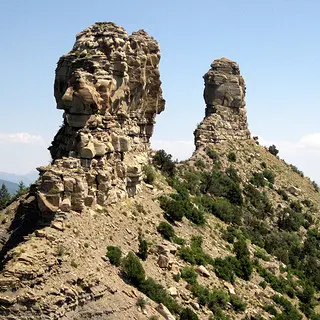
Native American History
Chimney Rock National Monument
Between A.D. 925 and 1125, the ancestors of the modern Pueblo Indians occupied the lands around Chimney Rock. Today, hundreds of archaeological sites survive within sight of Chimney Rock's soaring twin rock spires, including the Great House Pueblo. Chimney Rock is open to the public for five months each year and is visited by approximately 9,000 people each season. Unfortunately, it receives inadequate funding and exists with no clear protection for sites within the archaeological area.

On Chimney Rock looking over Petersen Ridge.

photo by: Tobias Hoellrich
Chimney Rock is open to the public for five months each year.

A group tour in front of a prehistoric wall.
The National Trust believes that the 4,726-acre Chimney Rock Archaeological Area is the single most important cultural site managed by the U.S. Forest Service.
Campaign Goals
- Establish Chimney Rock as a National Monument to be managed by the U.S. Forest Service with a designated monument manager
- Provide continued traditional use of Chimney Rock by tribes and pueblos
- Manage the new monument with a plan crafted with community involvement, and continue to allow the Chimney Rock Interpretive Association to operate the site
- Inspire an improved preservation and funding ethic for the historic and cultural resources managed by the U.S. Forest Service
Partners
- Chimney Rock Interpretive Association
- Colorado Senators Bennet and Udall, Rep. Tipton
- All Indian Pueblo Council
- Crow Canyon Archaeological Center
- San Juan Citizens Alliance
- U.S. Forest Service
- Archuleta County Commissioners
- City of Pagosa Springs
- Chamber of Commerce of Pagosa Springs
- Colorado Preservation Inc.
Success!
On September 21, 2012, the Chimney Rock Archaeological Area was named a National Monument by President Barack Obama.
Visit Chimney Rock National Monument.
Plan Your VisitSupport our work to save places that matter.
DonateStay connected with us via email. Sign up today.
Related Stories
Explore More Places
We believe all Americans deserve to see their history in the places that surround us. As a nation, we have work to do to fill in the gaps of our cultural heritage.
Let's Get to Work



